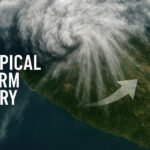In the heart of the Sonoran Desert, the air today feels like it’s humming, not with life, but with heat. Tucson weather has dialed up its summer drama, pushing thermometers to a blistering 108 °F this afternoon, the kind of number that feels more like a dare than a forecast. Step outside, and you’re met with an invisible wall of heat, dry and relentless, hugging every surface, every breath. But hold onto your hats, literally. What starts as an oven is about to get stirred by stormy fingers, as monsoon moisture slips in from New Mexico, hinting at a rapid weather shift just over the desert’s glowing edge.
Right now, Tucson is at peak summer intensity. The sun is an unblinking eye above the Rincon Mountains, and the desert floor reflects that energy with a furnace-like quality. The Tucson weather advisory is clear: stay cool, stay shaded, stay alert. The National Weather Service extended its Extreme Heat Warning through this evening, with heat index values touching 101 °F, even though humidity levels are scraping the bottom near 18 %. The sky, while mostly blue, has begun to wear streaks of high-level cloud, smeared east to west by upper-level breezes, and this veil is the first sign of what’s coming.
Driving down I-10, visibility isn’t what it was just yesterday. Blowing dust is already a hazard east of the city, where gusts funnel through open plains, lifting dry desert soil into the air like powdered chalk. The visibility drops quickly, especially near Willcox and parts of Cochise County, where a Blowing Dust Advisory has already been issued. It’s that time of year when a clear blue morning doesn’t guarantee a peaceful afternoon. Dust storms—haboobs—can rise like beasts from the basin floor, triggered by outflow winds from collapsing thunderstorms that never quite make it to the valley.
But those storms are building. Not over Tucson, not just yet, but over the mountains to the east—Mount Graham, the Chiricahuas, even Mount Lemmon may start to seed some high-based cumulonimbus clouds later this evening. This kind of development is classic in early monsoon setups, where the lower atmosphere is still too dry for wide-reaching rainfall, but upper levels begin to prime the engine. Rain from these storms may never hit the ground; instead, it evaporates in dry air layers and triggers powerful downdrafts. These are dry microbursts—sudden gusts that slam into the ground and push out in all directions, capable of generating 40 to 60 mph winds and blowing sand across highways before any lightning strike is even seen.
Meteorologists are watching what they call a “back-door front”—a rare southeast-to-northwest surface wind pattern that’s nudging its way into Southern Arizona through New Mexico. It’s already arrived in the far southeast corners of the state, pulling in deeper moisture that’ll change the game starting tomorrow. By mid-week, Tucson weather won’t just be about scorching heat. It will be about storm coverage, localized flooding and the return of flash-flood alerts for desert washes that have been bone-dry for months.
Tuesday will still feel hot, with highs hovering around 108 °F again, but clouds will pop sooner. Storm chances rise in the afternoon, especially east of town. Don’t expect uniform coverage—this will be a hit-or-miss setup, with some neighborhoods drenched while others stay dry. But by Wednesday, Tucson transitions into a more typical monsoon rhythm. Highs drop closer to 100 °F, and storms become more widespread, especially after 2 p.m. That moisture surge, powered by the Gulf of California and aided by the shifting ridge overhead, should bring in enough instability for deeper convective towers, more rain reaching the ground and less virga teasing the sky.
If you’re thinking of Fourth of July plans, the weather may cooperate just enough. The extreme heat will loosen its grip, with highs likely in the mid to upper 90s across the metro. Storm chances might back off slightly Friday, offering partial relief, but moisture from Sonora could reload the system by Saturday. That means the weekend might serve up another round of afternoon storms and possibly some dramatic lightning shows over the Catalinas.
Beyond the holiday, the Climate Prediction Center gives a solid nudge toward wetter-than-average conditions for southeastern Arizona through mid-July. That’s a hopeful trend, especially after June closed as one of the driest and hottest in years. Tucson’s soil is parched. Washes like Sabino and Tanque Verde are cracked open, waiting for flow. A real monsoon burst this week could fill them fast, turning peaceful desert trails into churning, silty rivers. As always, heed the signs: Turn Around, Don’t Drown.
What makes Tucson weather so compelling this time of year isn’t just the heat, or the storms. It’s the tension between the two. The desert isn’t passive—it fights back. When it gets too hot, it shifts the balance. It pulls in clouds, it breathes in humidity, and it throws storms with fierce beauty and precision. There’s power in the silence of the morning heat, and there’s release in the clatter of rain on mesquite branches at dusk. This week will bring both. First the blaze, then the break. That’s monsoon season for you—pure atmospheric theater in the Arizona sky.
For now, stay weather aware. Keep extra water in your car, don’t underestimate wind gusts or the speed at which skies can darken. Prepare for the first real downpours of the season, maybe not today, but soon. Because when the monsoon curtain finally rises in Tucson, it doesn’t whisper. It roars.


